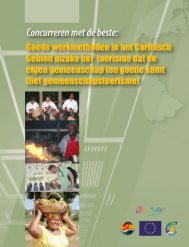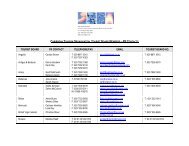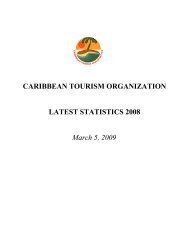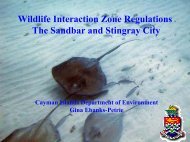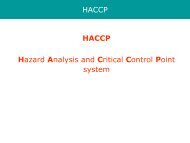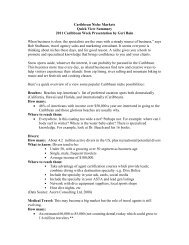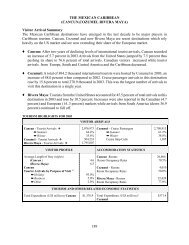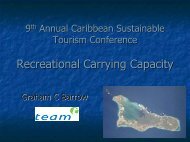Disaster Risk Management Strategy and Plan of Action - Caribbean ...
Disaster Risk Management Strategy and Plan of Action - Caribbean ...
Disaster Risk Management Strategy and Plan of Action - Caribbean ...
Create successful ePaper yourself
Turn your PDF publications into a flip-book with our unique Google optimized e-Paper software.
Regional <strong>Disaster</strong> <strong>Risk</strong> <strong>Management</strong> <strong>Strategy</strong> for the Tourism Sector in the <strong>Caribbean</strong> – Final<br />
response planning between this business <strong>and</strong> the host community. In some cases, these linkages have been<br />
found wanting 18 .<br />
Case studies from Central America <strong>and</strong> the <strong>Caribbean</strong> (Haiti <strong>and</strong> the Dominica Republic) demonstrated<br />
that the private sector will <strong>and</strong> can help communities mitigate disasters. The key characteristics that drove<br />
the initiatives were that each <strong>of</strong> the communities had: multiple hazards, a history <strong>of</strong> disasters, committed<br />
local leadership, committed Non-governmental organizations (NGOs) <strong>and</strong> well-established businesses.<br />
This initiative was not nearly as successful in cases where one or more <strong>of</strong> these elements were missing. The<br />
key lessons learned were that the private sector will get involved if it is clear that results will benefit them;<br />
<strong>and</strong>, local leaders, who are supportive, can motivate others to participate 19 . Government therefore must<br />
provide a support framework to maximize the potential contribution <strong>of</strong> the private sector to disaster risk<br />
management.<br />
(6) Fostering Leadership <strong>and</strong> Cooperation in the Region<br />
The region's pattern <strong>of</strong> development <strong>and</strong>, more specifically, the persistence <strong>of</strong> widespread poverty, rapid<br />
<strong>and</strong> uncontrolled urbanization <strong>and</strong> environmental degradation have led to an increase in its vulnerability to<br />
natural hazards. Evidence suggests that the region’s propensity to experience damage <strong>and</strong> its difficulties in<br />
recovering from disasters are growing 20 . (IDB, 2000)<br />
The <strong>Caribbean</strong> region does not benefit from a common regional approach to DRM that is supported by all<br />
countries. However, the participating states <strong>of</strong> the <strong>Caribbean</strong> <strong>Disaster</strong> Emergency <strong>Management</strong> Agency<br />
(CDEMA) enjoy a considerable level <strong>of</strong> cooperation in DRM matters through their joint adherence to the<br />
Comprehensive <strong>Disaster</strong> <strong>Management</strong> (CDM) <strong>Strategy</strong> <strong>and</strong> Framework <strong>and</strong> is de facto the most widely<br />
accepted regional DRM approach Participating states have benefited tremendously from resource material<br />
<strong>and</strong> training <strong>of</strong> resource persons as well as from sharing established mechanisms for support <strong>and</strong><br />
communication protocols at the national <strong>and</strong> regional levels.<br />
A proactive <strong>and</strong> comprehensive approach at the national level remains a challenge. The experiences <strong>of</strong><br />
various case studies demonstrate that leadership <strong>and</strong> commitment at the highest political level go a long<br />
way in not only establishing a culture <strong>of</strong> prevention but improving organizational <strong>and</strong> institutional<br />
arrangements.<br />
1.3.2 Implications for a Regional DRM Tourism <strong>Strategy</strong><br />
Given the critical importance <strong>of</strong> tourism to the sustainable development <strong>of</strong> <strong>Caribbean</strong> countries <strong>and</strong> the<br />
vulnerability <strong>of</strong> both the sector <strong>and</strong> the region to events induced by natural hazards, DRM is essential to<br />
the economic <strong>and</strong> physical resilience <strong>of</strong> both sector <strong>and</strong> the region. The pervasive nature <strong>of</strong> the industry<br />
means that DRM efforts are needed by all stakeholders at the individual venue, local, national <strong>and</strong> regional<br />
levels to reduce their individual <strong>and</strong> collective vulnerability to hazards <strong>and</strong> assure continued sustainable<br />
development following inevitable events.<br />
18 Le Groupe-conseil baastel ltee. Establishment <strong>of</strong> a Monitoring <strong>and</strong> Evaluation Framework through the Collection <strong>of</strong> Baseline<br />
Data for the Regional <strong>Disaster</strong> <strong>Risk</strong> <strong>Management</strong> for Sustainable Tourism in the <strong>Caribbean</strong> Project, Report on Baseline Data<br />
Collection Findings, 2007.<br />
19 International <strong>Strategy</strong> for <strong>Disaster</strong> Reduction (2008). Private Sector Activities in <strong>Disaster</strong> <strong>Risk</strong> Reduction. Good Practices <strong>and</strong><br />
Lessons Learned<br />
7, 20 Inter-American Development Bank, 2000. Facing the Challenge <strong>of</strong> Natural <strong>Disaster</strong> in Latin America <strong>and</strong> the <strong>Caribbean</strong>:<br />
An IDB <strong>Action</strong> <strong>Plan</strong><br />
9





